

Ce que l'on sait d'Oumuamua, l'astéroïde provenant d'un autre système solaire. Two mysterious bright spots on dwarf planet Ceres are not alike - space - 13 April 2015. The unidentified bright spots on dwarf planet Ceres have become more mysterious.

The spots on the surface were first glimpsed close-up just a month ago, and now infrared images reveal that they have different thermal properties. NASA's Dawn spacecraft is currently in orbit around the dwarf planet, which sits in the asteroid belt between Mars and Jupiter. Mission scientists presented the latest results from the spacecraft at the European Geosciences Union General Assembly in Vienna, Austria, today.
Two spots on the surface, labelled feature one and feature five, show up in visible light images as very bright in comparison to the rest of Ceres's dull grey, leading to speculation that they could be the sites of watery volcanoes on the dwarf planet, also known as cryovolcanoes. Now Federico Tosi, who works on Dawn's Visible and Infrared Spectrometer, has presented infrared images of the two spots, measuring their thermal properties. Hide the volcanoes. Space in Images - 2013 - 11 - Bizarre six-tailed asteroid. Description This NASA/ESA Hubble Space Telescope image reveals a never-before seen set of six comet-like tails radiating from a body in the asteroid belt.Now designated P/2013 P5, the asteroid was discovered as an unusually fuzzy-looking object by astronomers using the Pan-STARRS survey telescope in Hawaii.
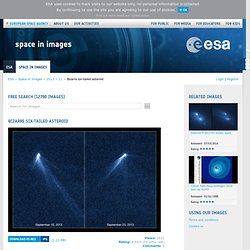
The multiple tails were discovered in Hubble images taken on 10 September 2013.When Hubble returned to the asteroid on 23 September its appearance had totally changed – it looked as if the entire structure had swung around.One interpretation is that the asteroid’s spin has increased to the point where dust is being flung off the surface and escaping into space, where it is swept out into tails by the pressure of sunlight.According to this theory, the asteroid’s rotation has been accelerated by the gentle push of sunlight. La désintégration mystérieuse d'un astéroïde a été observée par deux astronomes.
Space in Images - 2014 - 02 - Asteroid P/2013 R3 breaks apart. Astéroïde. Un article de Wikipédia, l'encyclopédie libre.

163825-asteroid. Asteroids and Comets. Orbit Diagrams. Les astéroïdes, une épée de Damoclès. À l’heure où les grands Tyrannosaurus rex carnivores chassaient et où les énormes Diplodocus paissaient tranquillement, un astéroïde se dirigeait à toute vitesse vers la Terre.
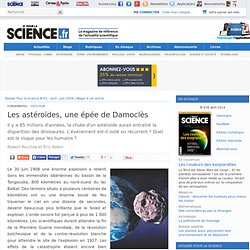
La violente collision qui s’ensuivit dispersa des centaines de milliards de tonnes de débris et engendra un gigantesque incendie. Le jour devint nuit. Et si le scénario se répétait ? Chris Butler/Science Photo Library/Cosmos. Orbites des astéroïdes géocroiseurs. Potentially hazardous object. Plot of orbits of known Potentially Hazardous Asteroids (size over 460 feet (140 m) and passing within 4.7 million miles (7.6×10^6 km) of Earth's orbit) as of early 2013 (alternate image).
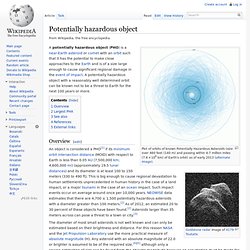
A potentially hazardous object (PHO) is a near-Earth asteroid or comet with an orbit such that it has the potential to make close approaches to the Earth and is of a size large enough to cause significant regional damage in the event of impact. A potentially hazardous object with a reasonably well determined orbit can be known not to be a threat to Earth for the next 100 years or more.
Overview[edit] The diameter of most small asteroids is not well known and can only be estimated based on their brightness and distance. For this reason NASA and the Jet Propulsion Laboratory use the more practical measure of absolute magnitude (H). The two main scales used to categorize the impact hazards of asteroids are the Palermo Technical Impact Hazard Scale and the Torino Scale.
List of Earth-crossing minor planets. Diagram showing different asteroid paths.

The yellow band marks the Earth's orbit; the red line marks the asteroid's path.Outer-grazer(†): middle, bottomCrosser: right, bottom Close approach trajectory of 2004 FH in the Earth–Moon system. Sormano Astronomical Observatory: TECA - Table of Asteroids Next Closest Approaches to the Earth. Last update: April 12, 2014 Computations: Piero Sicoli, Francesco Manca (obs.sormano@alice.it).
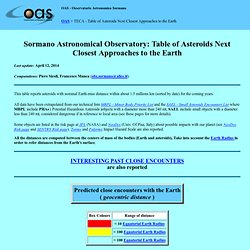
This table reports asteroids with nominal Earth-miss distance within about 1.5 millions km (sorted by date) for the coming years. All data have been extrapolated from our technical lists MBPL - Minor Body Priority List and the SAEL - Small Asteroids Encounters List where MBPL include PHAs ( Potential Hazardous Asteroids )objects with a diameter more than 240 mt, SAEL include small objects with a diameter less than 240 mt, considered dangerous if in reference to local area (see these pages for more details). Some objects are listed in the risk page at JPL (NASA) and NeoDys (Univ. Of Pisa, Italy) about possible impacts with our planet (see NeoDys Risk page and SENTRY Risk page). All the distances are computed between the centers of mass of the bodies (Earth and asteroids), Take into account the Earth Radius in order to refer distances from the Earth's surface. Equatorial Earth Radius= 6378.14 Km. List Of The Potentially Hazardous Asteroids (PHAs) Apophis, risque d'impact. Astéroïde Apophis : la Russie prévoit une sonde pour protéger la Terre.
Astéroïdes. Un astéroïde est une petite planète dont les dimensions ne dépassent pas quelques centaines de kilomètres.
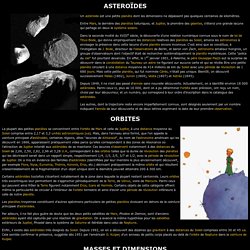
Entre Mars, la dernière des planètes telluriques, et Jupiter, la première des géantes, s'étend une grande lacune qui partage en deux le système solaire. Dans la seconde moitié du XVIIIe siècle, la découverte d'une relation numérique connue sous le nom de loi de Titus-Bode, qui donne empiriquement les distances relatives des planètes au Soleil, amena les astronomes à envisager la présence dans cette lacune d'une planète encore inconnue. C'est ainsi que se constitua, à l'instigation de J. Bode, directeur de l'observatoire de Berlin, et baron von Zach, astronome amateur hongrois, un groupe d'observateurs dont l'objectif était de rechercher systématiquement la planète mystérieuse. Cette "police du ciel" fut pourtant devancée. Histoires d'impacts. Asteroids with satellites. Contents: List of binary asteroids/TNOs--by class or by designation, with orbital class of object in parenthesis (Follow links to pages with data and links on specific objects, including links to abstracts at ADS): Link to list by date of announcement of detection.
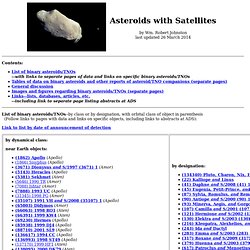
Asteroid Discovery from 1980 - 2011 (4K HD version) Close Call Asteroid Photographed.